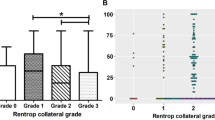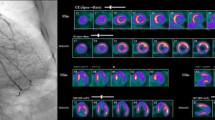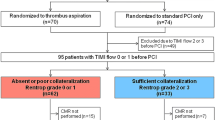Abstract
Revascularization of chronic total occlusion (CTO) is still debated regarding its indications and therapeutic benefits. Guidelines recommend patient selection based on ischemia detection and viability assessment. We aimed to investigate the relationship between the quality of coronary collaterals (CC), graded by Rentrop classification, and myocardial viability assessed by cardiovascular magnetic resonance (CMR). Unselected 100 consecutive patients with a single CTO were prospectively enrolled. CC of Rentrop grade two or three were considered as well-developed. Analyzing late gadolinium enhancement (LGE) images, CTO territories with mean segmental transmural scar extent < 50% were considered viable. Of the 100 patients (70 male, mean age 58.0 ± 6 years), 73 patients (73%) had angiographically visible CC. Based on LGE, patients were classified into viable (n = 50) and non-viable (n = 50) groups. Significant differences between both groups existed regarding frequency of diabetes mellitus (p = 0.044), frequency of congestive heart failure (p = 0.032), presence of pathological Q in CTO territory (p = 0.039); and presence of well-developed CC (p < 0.001). Binary logistic regression and receiver operating characteristic curve showed that presence of well-developed CC could independently (OR 9.4, 95% CI: 2.6–33.6, p < 0.001) predict myocardial viability with a sensitivity and a specificity of 72% and 74%, respectively (AUC: 0.796, 95% CI: 0.708—0.884, P < 0.001). The presence of well-developed CC could independently predict with high accuracy myocardial viability assessed by LGE in territories subtended by CTO vessels. Therefore, search for viable myocardium using different imaging modalities, e.g. CMR, may be recommended in CTO patients with well-developed CC.



Similar content being viewed by others
References:
Fefer P, Knudtson ML, Cheema AN et al (2012) Current perspectives on coronary chronic total occlusions: the canadian multicenter chronic total occlusions registry. J Am Coll Cardiol 59:991–997
Jeroudi OM, Alomar ME, Michael TT et al (2014) Prevalence and management of coronary chronic total occlusions in a tertiary veterans affairs hospital. Catheter Cardiovasc Interv 84:637–643
Werner GS, Gitt AK, Zeymer U et al (2009) Chronic total coronary occlusions in patients with stable angina pectoris: impact on therapy and outcome in present day clinical practice. Clin Res Cardiol 98:435–441
Raja V, Wiegn P, Obel O et al (2015) Impact of chronic total occlusions and coronary revascularization on all-cause mortality and the incidence of ventricular arrhythmias in patients with ischemic cardiomyopathy. Am J Cardiol 116:1358–1362
Olivari Z, Rubartelli P, Piscione F et al (2003) Immediate results and one-year clinical outcome after percutaneous coronary interventions in chronic total occlusions: data from a multicenter, prospective, observational study (TOAST-GISE). J Am Coll Cardiol 41:1672–1678
Henriques JP, Hoebers LP, Ramunddal T et al (2016) Percutaneous intervention for concurrent chronic total occlusions in patients with STEMI: the EXPLORE trial. J Am Coll Cardiol 68:1622–1632
Neumann FJ, Sousa-Uva M, Ahlsson A et al (2019) 2018 ESC/EACTS guidelines on myocardial revascularization. Eur Heart J 40:87–165
Shan K, Constantine G, Sivananthan M, Flamm SD (2004) Role of cardiac magnetic resonance imaging in the assessment of myocardial viability. Circulation 109(11):1328–1334
Lee WC, Park SW, Cho GY et al (2000) Pressure-derived fractional collateral blood flow: a primary determinant of left ventricular recovery after reperfused acute myocardial infarction. J Am Coll Cardiol 35:949–955
Rogers W, Hood WP, Mantle JA et al (1984) Return of left ventricular function after reperfusion in patients with myocardial infarction: Importance of subtotal stenoses or intact collaterals. Circulation 69:338–349
Fujita M, Ohno A, Wada O et al (1991) Collateral circulation as a marker of the presence of viable myocardium in patients with recent myocardial infarction. Am Heart J 122:409–414
Jang WJ, Yang JH, Choi SH, Song YB, Hahn JY, Choi JH, Kim WS, Lee YT, Gwon HC (2015) Long-term survival benefit of revascularization compared with medical therapy in patients with coronary chronic total occlusion and well-developed collateral circulation. JACC Cardiovasc Intv 8(2):271–279
Di Carli M, Sherman T, Khanna S et al (1994) Myocardial viability in asynergic regions subtended by occluded coronary arteries: relation to the status of collateral flow in patients with chronic coronary artery disease. J Am Coll Cardiol 23:860–868
Aboul-Enein F, Kar S, Hayes SW et al (2004) Influence of angiographic collateral circulation on myocardial perfusion in patients with chronic total occlusion of a single coronary artery and no prior myocardial infarction. J Nucl Med 45:950–955
Dong W, Li J, Mi H et al (2018) Relationship between collateral circulation and myocardial viability of 18F-FDG PET/CT subtended by chronic total occluded coronary arteries. Ann Nucl Med 32:197–205
Sun X, Li S, Fang W et al (2020) Preserved myocardial viability in patients with chronic total occlusion of a single coronary artery. J Nucl Cardiol. https://doi.org/10.1007/s12350-020-02134-z
Choi J, Shang S, Choi J et al (2013) Frequency of myocardial infarction and its relationship to angiographic collateral flow in territories supplied by chronically occluded coronary arteries. Circulation 127:703–709
Małek LA, Śpiewak M, Kłopotowski M et al (2015) Combined analysis of myocardial function, viability, and stress perfusion in patients with chronic total occlusion in relation to collateral flow. Kardiol Pol 73:909–915
Schumacher SP, Everaars H, Stuijfzand WJ et al (2020) Association between coronary collaterals and myocardial viability in patients with a chronic total occlusion. EuroIntervention 16(6):e453–461. https://doi.org/10.4244/EIJ-D-19-01006
Wang L, Lu M, Feng L, Wang J, Fang W, He Z et al (2018) Relationship of myocardial hibernation, scar, and angiographic collateral flow in ischemic cardiomyopathy with coronary chronic total occlusion. J Nucl Cardiol. https://doi.org/10.1007/s12350-018-1241-8
Zhang J, Li Y, Li M et al (2014) Collateral vessel opacification with CT in patients with coronary total occlusion and its relationship with downstream myocardial infarction. Radiology 271:703–710
Rentrop KP, Cohen M, Blanke H, Phillips RA (1985) Changes in collateral channel filling immediately after controlled coronary artery occlusion by an angioplasty balloon in human subjects. J Am Coll Cardiol 5:587–592
Ripley DP, Gosling OE, Bhatia L et al (2014) The relationship between the contralateral collateral supply and myocardial viability on cardiovascular magnetic resonance: can the angiogram predict functional recovery? Int J Cardiol 177(2):362–367
Schulz-Menger J, Bluemke D, Bremerich J et al (2013) Standardized image interpretation and post processing in cardiovascular magnetic resonance: society for cardiovascular magnetic resonance (SCMR) board of trustees task force on standardized post processing. J CardiovascMagnReson 15:35
Hombach V, Merkle N, Bernhard P et al (2010) Prognostic significance of cardiac magnetic resonance imaging: update 2010. Cardiol J 17:549–557
Kim RJ, Wu E, Rafael A et al (2000) The use of contrast-enhanced magnetic resonance imaging to identify reversible myocardial dysfunction. N Engl J Med 343:1445–1453
Romero J, Xue X, Gonzalez W, Garcia MJ (2012) CMR imaging assessing viability in patients with chronic ventricular dysfunction due to coronary artery disease: a meta-analysis of prospective trials. JACC Cardiovasc Imaging 5:494–508
Cohen MV (1985) Coronary collaterals: clinical & experimental observations. Futura Pub Co, Mount Kisco, N.Y.
Fukai M, Ii M, Nakakoji T, Kawakatsu M, Nariyama J, Yokota N et al (2000) Angiographically demonstrated coronary collaterals predict residual viable myocardium in patients with chronic myocardial infarction: a regional metabolic study. J Cardiol 35:103–111
Werner GS, Emig U, Mutschke O et al (2003) Regression of collateral function after recanalization of chronic total coronary occlusions: a serial assessment by intracoronary pressure and doppler recordings. Circulation 108:2877–2882
Sabia PJ, Powers ER, Ragosta M, Sarembock IJ, Burwell LR, Kaul S (1992) An association between collateral blood flow and myocardial viability in patients with recent myocardial infarction. N Engl J Med 327:1825–1831
Kaul S (2015) Assessment of myocardial collateral blood flow with contrast echocardiography. Korean Circ J 45(5):351–356
Aneja A, Tang WH, Bansilal S et al (2008) Diabetic cardiomyopathy: insights into pathogenesis, diagnostic challenges, and therapeutic options. Am J Med 121:748–757
Shen Y, Ding FH, Dai Y et al (2018) Reduced coronary collateralization in type 2 diabetic patients with chronic total occlusion. Cardiovasc Diabetol 17:26
Funding
none.
Author information
Authors and Affiliations
Corresponding author
Ethics declarations
Conflict of interest
All authors declare that they have no conflict of interest.
Ethical approval
Approved by ZU-IRB #4736/3–7-2018.
Additional information
Publisher's Note
Springer Nature remains neutral with regard to jurisdictional claims in published maps and institutional affiliations.
Rights and permissions
About this article
Cite this article
Shokry, K.AA., Farag, ES.M., Salem, A.M.H. et al. Relationship between quality of coronary collateral and myocardial viability in chronic total occlusion: a magnetic resonance study. Int J Cardiovasc Imaging 37, 623–631 (2021). https://doi.org/10.1007/s10554-020-02027-9
Received:
Accepted:
Published:
Issue Date:
DOI: https://doi.org/10.1007/s10554-020-02027-9




